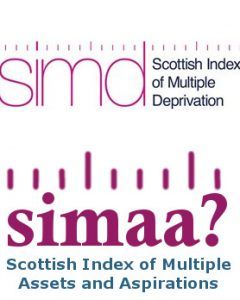
SIMAA aims to complement SIMD
Regeneration practitioners in Scotland will be familiar with SIMD – the Scottish Index of Multiple Deprivation. SIMD gathers data on 38 social and economic indicators in broad areas such as income, housing, health and crime for just under 7000 small area ‘datazones’ across the country. Most recently updated in August 2016, this data is used to produce an overall index that ranks these datazones, each with around 750 residents, from least to most deprived.
SIMD is designed as a tool to provide context for place-specific challenges and to direct regeneration investments to areas with the highest deprivation levels. There are, however, concerns about the negative impact of the way in which its findings are sometimes presented.
People living and working in our Alliance for Action programme areas of Govan, Rothesay and East Kirkcaldy – all of which have datazones in the 10% nationally most deprived – told SURF they felt media coverage around the publication of the 2016 SIMD was stigmatising and unbalanced. They were concerned that SIMD data was being used to negatively label communities as continuously multi-deprived – while ignoring positive changes.
SURF has responded with a proposal which will enable communities to present the positive aspects of their lives and counteract the SIMD labels of multi-deprivation. We have drafted and shared a proposal for SIMAA – a Scottish Index of Multiple Assets and Aspirations. SURF will run SIMAA on a pilot basis in Alliance for Action areas in 2017 by working with the local communities, academic partners, and the Scottish Government.
SURF’s proposal paper is available for download below. If you would like to receive SIMAA project updates, please join our e-bulletin mailing list or visit our SIMAA webpage. SIMAA is managed by SURF’s Practice and Learning Coordinator, Dr Elaine Cooper (elaine@surf-old.local).
